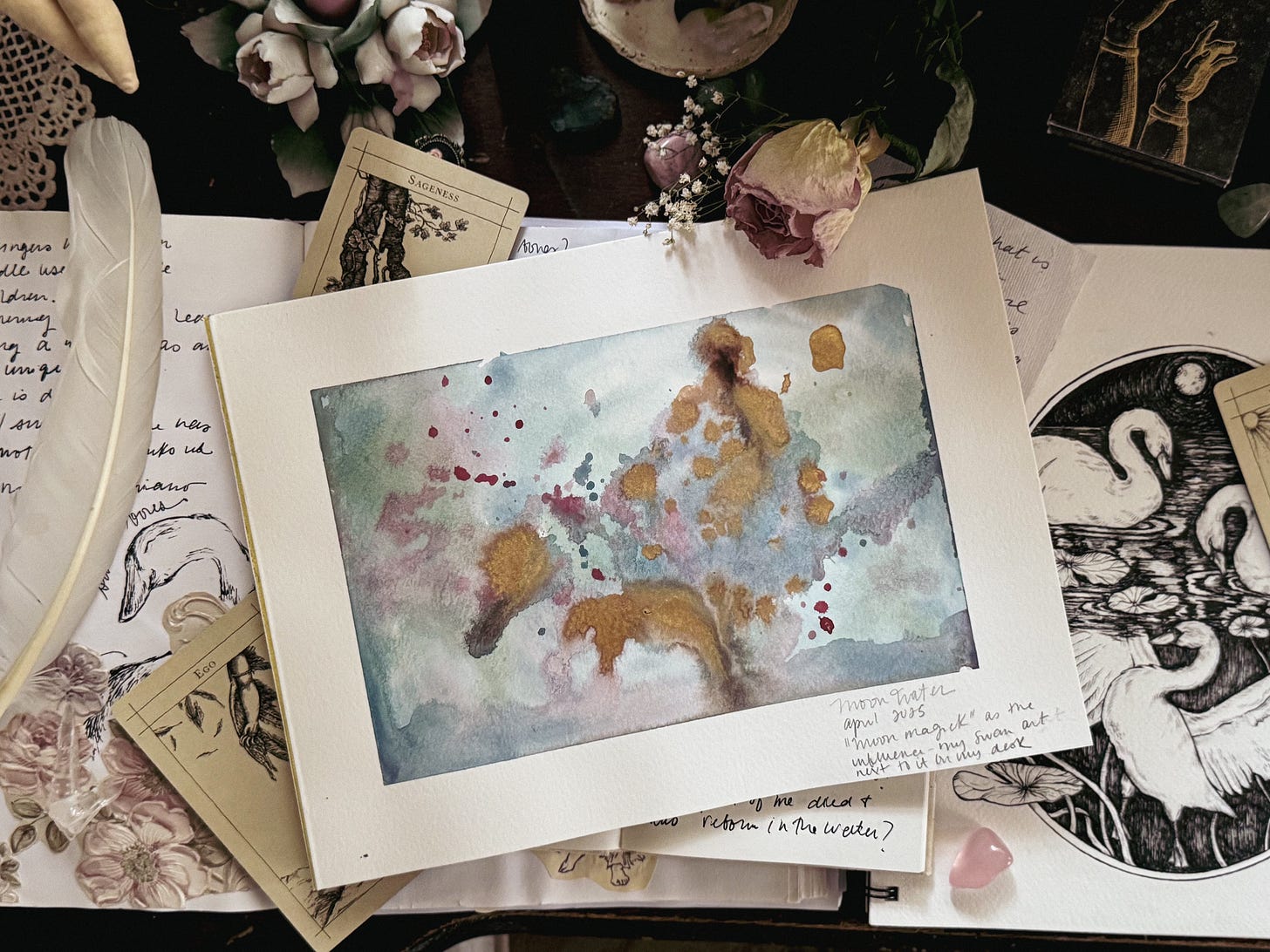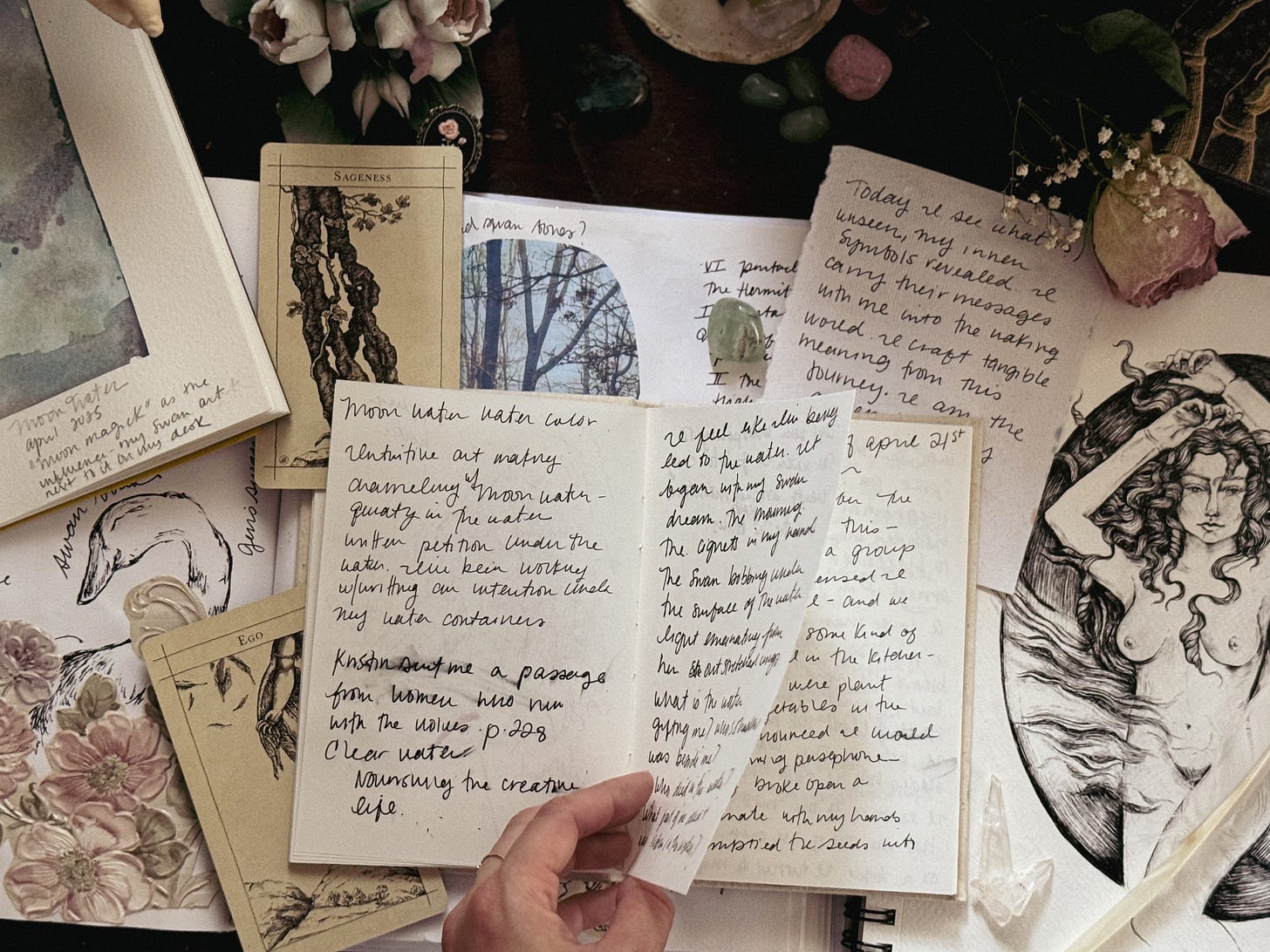Welcome to part 6 of our series on Creative Mediumship, Creative Mediumship: Symbolic Illumination. In these conversations, we’re exploring the intersections of creativity, consciousness, trance, magick, and imagination. If you’re new to the Literary Coven, start at the beginning with Creative Mediumship: Spells for Spring, then head over to The Threshold: A Writing Ritual from Kate Belew, before checking out Imagination is the Medium: A Psychic Experiment for the Literary Coven , The Cloak Within: A Writing Ritual from Sarah Justice , and The Journey with Jennifer Green. If you’re new to the halls of Pointy Hat Press, join the Literary Coven for a journey into and through the landscape of the unseen.
“The world, like a great iris of an even more gigantic eye, which has also just opened and stretched out to encompass everything, stared back at him.”
― Ray Bradbury, “Dandelion Wine”
This past April, inspired by the unfurling of spring, we set out on a quest to explore the intersections of creativity, consciousness, trance, and magick, or what we call creative mediumship.
What is Creative Mediumship?
Creative mediumship is the practice of treating your creative world as a doorway. It’s intuitive art-making and channeled writing. It’s summoning music through our dreams for a new song or score. If we’re weaving stories into tapestries, crafting desk altars for our muses, or ritualizing our creativity alongside our magical world in a way that makes us feel alive, we’re already engaged with this practice.
Creative mediumship is befriending the inherently weird and wondrous parts of ourselves and letting the language of mystery guide our quill.
Over the past few months, we’ve invited friends, makers, and inspiring humans to join us on the Pointy Hat Press podcast to discuss their connection to creativity. We wanted to know: Who were their muses? How do they engage with trance or channeling? In what ways do their dreams serve as guides?
You can listen to all the episodes here (Spotify) or here (Apple Podcasts), but the big takeaway is this:
The creative spirit is ever-present. It’s also a shapeshifter. Sometimes it speaks clearly, confidently, like a long-lost friend; other times it slithers in and around our curiosities, making nests within our imaginations. Sometimes the creative spirit takes the shape of a goddess, a mythical creature, or a childhood muse. This entity can arrive as a shooting star or a synchronicity too peculiar to be ignored. For makers and mystics, the realm of spirit and inspiration flickers at the crossroads of our waking desires, our nightly dreams, our art, and our oldest, most enduring memories. But when the spirit world opens its mouth, it isn’t words that tumble out, but symbols. Symbols are inherently mysterious, their meanings are both veiled and illuminated by our creative work.
“Think of mystery as one of our senses. As a sense, it is a delectable component of conscious contemplation, one that provides much wonderment, awe, and delight. Mystery activates the imagination, it provokes and electrifies our spirit, it is the poetry of life, the shadow within the prose of the known. As human beings, we are not just seeking knowledge, information, or even meaning. We want rapture; we crave cosmic connection; we love joy; we need to adore something.”
“Initiation into Dream Mysteries: Drinking from the Pool of Mnemosyne,” Sarah Janes
Symbols can be sensory or supernatural. A symbol can take the form of a name, sigil, color, or a direction on our compass. Sometimes, we refer to symbols as correspondences. Heinrich Zimmer described symbols as words and concepts, “just as visions, rituals, and images are; so too are the manners and customs of daily life. Through all of these, a transcendent reality is mirrored…Symbols hold the mind to truth but are not themselves the truth, hence, it is delusory to borrow them. Each civilization, every age, must bring forth its own."
Working with Symbols
Each of us possesses symbols unique to our lives. These personal symbols might be related to our favorite book, a beloved familiar, or the overall landscape of our creative work. There are also collective symbols, iconography created by a group of people and passed down over the span of many years. A myth is one kind of collective symbol.
In the story of Persephone and Demeter, a tale that has been discussed, dissected, and retold for thousands of years, readers experience a journey into and through the mythical abyss. Imagery greets us along the well-trodden path and we come face to face with a black chariot, a handful of wheat, and a pair of bronze sandals—symbolic breadcrumbs to nourish our inner student and seeker.
“When the myths are read and studied, the subconscious mind absorbs the symbols and the collective unconscious relates to them, even though the person on a conscious level sees nothing more than an entertaining story. This unconscious absorption of knowledge may be one reason why a great many mythologies were not lost through direct intent or forgetfulness.”
D.J. Conway, Maiden, Mother, Crone: The Myth & Reality of the Triple Goddess
Gazing at art and our creative work with a symbolic eye unites the conscious and unconscious parts of our psyche. If we want, we can think of the conscious and the unconscious as the physical and the ethereal, tendencies that are left-brained versus right-brained, or some version of the Hermetic concept, ‘As above, so below. As within, so without.’
Carl Jung suggested that a secret life holds sway in the unconscious, and symbols are the key to that world. He writes that:
“Symbols are spirit from above, and under those conditions, the spirit is above too. Therefore, it would be a foolish and senseless undertaking for such people to wish to experience or investigate an unconscious that contains nothing but the silent, undisturbed sway of nature. Our unconscious, on the other hand, hides living water, spirit that has become nature, and that is why it is disturbed. Heaven has become for us the cosmic space of the physicists, and the divine empyrean a fair memory of things that once were. But the heart glows, and a secret unrest gnaws at the roots of our being.”
For most of us, our creative work is a blend of conscious choice and unconscious surrender. Even if we don’t engage with trance or altered states, a channeled writing session is largely unconscious as we lean into our imagination and let our pens lead. However, editing and arranging a story from that same piece requires conscious effort. For painters and artists, the inspired scribbles they made on a napkin are the products of the unconscious, but transferring those scribbles onto a canvas after deciding on the layout and color scheme compels the conscious part of our psyche.
In his book, Astrology Is Real, Robb Breszny discusses the importance of symbols in his creative work, particularly in the context of astrology. Breszny describes astrology as a blend of psychology, storytelling, and mythology.
“Astrology is a symbol system that, when used with integrity, engenders soulful approaches for deepening our connection to life’s great mysteries—not predictions of literal events. It liberates and fertilizes our imaginations and encourages us to think less literally. It teaches us to visualize our destinies as mythic quests and deepens our connection to life’s gorgeous mysteries.”
Creative Mediumship: The Results of Our Psychic Experiment for the Literary Coven
At Pointy Hat Press, we believe the moments when we see, hear, and feel the unseen are altered states; they are oracular opportunities to channel inspiration and symbolic storytelling into our creative work. This past April, we invited the Literary Coven to participate in a psychic experiment, one that tested the idea that we are more than our physical bodies.
“This is what imagination is for, it's to fill in the gaps and to come up with your own explanations. The imagination is the doorway to theory, what we don't know, the part of us that questions - what if?”
Caitlyn Barone
How we see it: Channeling for creativity is more than just a method to fuel our artistic endeavors — it’s a way to build our relationship with the invisible. April’s step-by-step ritual was reserved for paid subscribers (thank you for supporting our work!), but the final step of this experiment was to create a piece of art using the symbols, fragments, and questions born from this spell. Whether we chose to craft a poem, drawing, weaving, writing, or even a dance was up to the maker.
Our in-house Art Witch, Caitlyn Barone, experimented with watercolors, poetry, and line drawing and shared many of her pieces on social media, asking fellow witches and artists what symbols and messages they gleaned from her work. Read on to see some of Caitlyn’s art and listen to her personal reflections from this psychic experiment in a conversation with her partner and Pointy Hat Press co-founder, Kristin Lisenby.
Keep reading with a 7-day free trial
Subscribe to Literary Coven to keep reading this post and get 7 days of free access to the full post archives.





